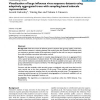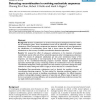371 search results - page 72 / 75 » Algorithms for phylogenetic footprinting |
BMCBI
2007
13 years 8 months ago
2007
Background: By virtue of their shared ancestry, homologous sequences are similar in their structure and function. Consequently, multiple sequence alignments are routinely used to ...
BMCBI
2008
13 years 8 months ago
2008
Background: With the amount of influenza genome sequence data growing rapidly, researchers need machine assistance in selecting datasets and exploring the data. Enhanced visualiza...
BMCBI
2008
13 years 8 months ago
2008
Background: Metagenomics is an approach to the characterization of microbial genomes via the direct isolation of genomic sequences from the environment without prior cultivation. ...
BMCBI
2008
13 years 8 months ago
2008
Background: Data mining in large DNA sequences is a major challenge in microbial genomics and bioinformatics. Oligonucleotide usage (OU) patterns provide a wealth of information f...
BMCBI
2006
13 years 8 months ago
2006
Background: Genetic recombination can produce heterogeneous phylogenetic histories within a set of homologous genes. These recombination events can be obscured by subsequent resid...


